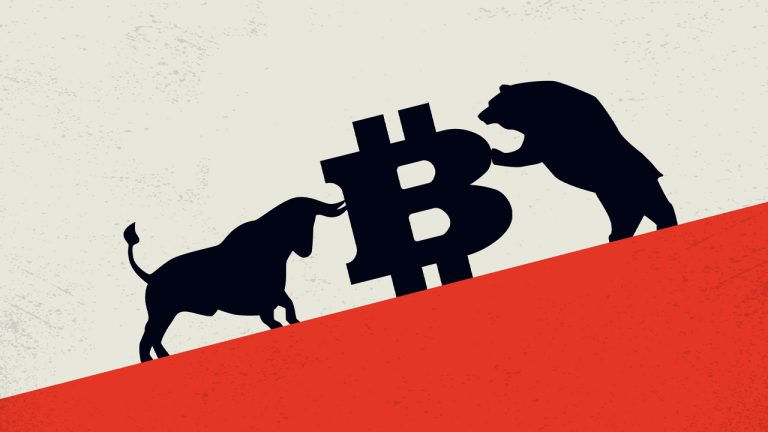
Sustained outperformance may hinge on whether US President-elect Donald Trump implements pro-crypto policies once he takes office on Jan. 20.
Cryptocurrency analysts are turning bullish after favorable US inflation data sent Bitcoin (BTC) surging some 3% amid hopes of more interest rate cuts.
On Jan. 15, the US Consumer Price Index (CPI) report tipped lower-than-expected core inflation in December, causing Bitcoin’s spot price to rally from around $96,000 to nearly $100,000. Other assets, including stocks and gold, also surged.
Futures markets assign a roughly 30% chance of the Federal Reserve, America’s central bank, cutting interest rates in March, according to CME FedWatch. Rate cuts generally benefit crypto.

A financial services giant with nearly $90 billion in assets under its management is shutting down its futures Bitcoin (BTC) exchange-traded fund (ETF) just days after the U.S. Securities and Exchange Commission approved a slew of spot market BTC ETFs. According to a new press release, New York-based investment management firm VanEck says that it […]
The post $89,500,000,000 Asset Manager To Shut Down Bitcoin Futures Exchange-Traded Fund Days After Approval of Spot ETFs appeared first on The Daily Hodl.

BTC's correction reveals a disconnect between pro traders' confidence and retail investors' skepticism amid regulatory shifts.
Bitcoin (BTC) briefly reached $38,000 on Nov. 24 but faced formidable resistance at the price level. On Nov. 27, Bitcoin price traded below $37,000, which is unchanged from a week ago.
What is eye catching is the unwavering strength of BTC derivatives, which signals that bulls remain steadfast with their intentions.
An intriguing development is unfolding in China as Tether (USDT) trades below its fair value in the local currency, the Yuan. This discrepancy often arises due to differing expectations between professional traders engaged in derivatives and retail clients involved in the spot market.
To gauge the exposure of whales and arbitrage desks using Bitcoin derivatives, one must assess BTC options volume. By examining the put (sell) and call (buy) options, we can estimate the prevailing bullish or bearish sentiment.

Since Nov. 22, put options have consistently lagged behind call options in volume, by an average of 40%. This suggests a diminished demand for protective measures—a surprising development given the intensified regulatory scrutiny following Binance's plewith the U.S. Department of Justice (DoJ) and the U.S. Securities and Exchange Commission's (SEC) lawsuit against Kraken exchange.
While investors may not foresee disruptions to Binance's services, the likelihood of further regulatory actions against exchanges serving U.S. clients has surged. Additionally, individuals who previously relied on obscuring their activity might now think twice, as the DoJ gains access to historical transactions.
Furthermore, it's uncertain whether the arrangement struck by Changpeng “CZ” Zhao with authorities will extend to other unregulated exchanges and payment gateways. In summary, the repercussions of recent regulatory actions remain uncertain, and the prevailing sentiment is pessimistic, with investors fearing additional constraints and potential actions targeting market makers and stablecoin issuers.
To determine if the Bitcoin options market is an anomaly, let's examine BTC futures contracts, specifically the monthly ones—preferred by professional traders due to their fixed funding rate in neutral markets. Typically, these instruments trade at a 5% to 10% premium to account for the extended settlement period.

Between Nov. 24 and Nov. 26, the BTC futures premium flirted with excessive optimism, hovering around 12%. However, by Nov. 27, it dipped to 9% as Bitcoin's price tested the $37,000 support—a neutral level but close to the bullish threshold.
Moving on to retail interest, there is a growing sense of apathy due to the absence of a short-term positive trigger, such as the potential approval of a spot Bitcoin exchange-traded fund (ETF). The SEC is not expected to make its final decision until January and February 2024.
The USDT premium relative to the Yuan hit its lowest point in over four months at OKX exchange. This premium serves as a gauge of demand among China-based retail crypto traders and measures the gap between peer-to-peer trades and the U.S. dollar.

Since Nov. 20, USDT has been trading at a discount, suggesting either a significant desire to liquidate cryptocurrencies or heightened regulatory concerns. In either case, it's far from a positive indicator. Furthermore, the last instance of a 1% positive premium occurred 30 days ago, indicating that retail traders aren't particularly enthused about the recent rally toward $38,000.
Related: What’s next for Binance’s Changpeng ‘CZ’ Zhao?
In essence, professional traders remain unfazed by short-term corrections, regardless of the regulatory landscape. Contrary to doomsday predictions, Binance's status remains unaffected, and the lower trading volume on unregulated exchanges may boost the chances of a spot Bitcoin ETF approval.
The disparity in time horizons may explain the divide between professional traders and retail investors' optimism. Additionally, recent regulatory actions could pave the way for increased participation by institutional investors, offering a potential upside in the future.
This article is for general information purposes and is not intended to be and should not be taken as legal or investment advice. The views, thoughts, and opinions expressed here are the author’s alone and do not necessarily reflect or represent the views and opinions of Cointelegraph.

Market analysts weigh in on an intriguing ‘flippening’, as Bitcoin futures open interest on global derivatives marketplace CME overtakes Binance.
Binance’s dominance of Bitcoin futures open interest has been toppled by traditional derivatives market place heavyweight Chicago Mercantile Exchange (CME), following Bitcoin’s first move past the $37,000 mark in over 18 months.
A number of analysts highlighted the ‘flippening’ of Binance by CME, with the latter overtaking the global cryptocurrency exchange for the largest share of Bitcoin futures open interest.
Wow, the real flippening that no one is talking about:
— Will (@WClementeIII) November 9, 2023
CME just flipped Binance for the largest share of Bitcoin futures open interest.
Bittersweet -- there will soon be more suits than hoodies here.
(h/t @VidiellaLaura) pic.twitter.com/SIPRLMlFcy
Open interest is a concept commonly used in futures and options markets to measure the total number of outstanding contracts. The metric represents the total number of contracts that are held by traders at any given point in time. The difference between the number of contracts that are held by buyers (longs) and the number of contracts held by sellers (shorts) determines open interest.

Bloomberg Intelligence exchange-traded fund (ETF) research analyst James Seyffart followed up an initial X (formerly Twitter) post from Will Clemente, questioning whether CME’s growing amount of Bitcoin futures open interest would appease the United States Securities and Exchange Commission’s (SEC) historical concerns over the depth of Bitcoin markets and the potential for market manipulation.
Okay this is interesting... Does this constitute 'market of significant size' now? haha https://t.co/eQb7QXvO3H
— James Seyffart (@JSeyff) November 9, 2023
This has long been a point of contention, which has led to the SEC holding back from approving several spot Bitcoin ETF applications over the past few years. The regulator previously told the likes of BlackRock and Fidelity that their filings were “inadequate” due to the omission of declarations relating to the markets in which the Bitcoin ETFs will derive their value.
Related: Bitcoin puzzles traders as BTC price targets $40K despite declining volume
In July 2023, the Chicago Board Options Exchange (CBOE) refiled a submission for Bitcoin spot ETFs following feedback from the SEC. Fidelity intends to launch its Bitcoin ETF product on CBOE, while BlackRock, the world’s largest asset manager, grabbed headlines for its proposed Bitcoin ETF, which is set to be offered on the Nasdaq.
CBOE’s amended filing with the SEC highlighted its efforts to take additional steps to ensure its ability to detect, investigate and deter fraud and market manipulation of shares in the proposed Wise Origin Bitcoin Trust.
“The Exchange is expecting to enter into a surveillance-sharing agreement with Coinbase, an operator of a United States-based spot trading platform for Bitcoin that represents a substantial portion of US-based and USD denominated Bitcoin trading.”
CBOE’s filing adds that the agreement with Coinbase is expected to carry the ‘hallmarks of a surveillance-sharing agreement.’ This will give CBOE supplemental access to Bitcoin trading data on Coinbase.
The stock exchange also added that Kaiko Research data indicated that Coinbase represented roughly 50% of the U.S. dollar to Bitcoin daily trading volume in May 2023. This is pertinent given the SEC’s misgivings over the depth of BTC markets to back ETF products.
A surveillance-sharing agreement is intended to ensure that exchanges and regulators are able to detect whether a market actor is manipulating the value of stocks or shares.
Magazine: US gov’t messed up my $250K Bitcoin price prediction: Tim Draper, Hall of Flame

Professional Bitcoin traders are favoring sideways price action as BTC futures premium drops and the options delta skew nears 0%
For the past 17 days, Bitcoin (BTC) price has been trading within a narrow 8.5% range from $27,250 to $29,550, causing the 40-day volatility metric to drop below 40%. This wasn't restricted to cryptocurrencies as the S&P500 index's historical volatility has reached 17%, its lowest level since December 2021.
But will $28,000 become the new resistance? Not according to the latest Bitcoin futures and options data. Nevertheless, macroeconomic conditions remain the main driver for risk markets’ price fluctuations in the near to medium terms.
A myriad of reasons could be given to explain the relatively low price oscillations in risk markets, including the expectation of a recession, investors unwilling to place new bets until the U.S. Federal Reserve ends its rate hikes, or increased demand (and focus) on fixed income trades.
The problem is that no one can prove what has been causing investors to restrict their risk appetite and drive Bitcoin’s price sideways. Many fear that commercial real estate is a growing concern, which could trigger major turbulence ahead—including Warren Buffett, the multi-billionaire fund manager.
While some believe that the U.S. debt ceiling discussion and the banking crisis could further cement the U.S. dollar’s weakening, Buffett does not foresee alternatives. The finance mogul is a long-term critic of the precious metal gold, as his investment thesis prioritizes yield-providing assets.
The debt ceiling drama has caused Treasury Secretary Janet Yellen to warn that a "steep economic downturn" would follow if Congress fails to act in the next few weeks.
On the one hand, the government is facing pressure to sustain economic activity and contain the banking crisis. Ultimately, increasing the debt limit will add liquidity to the markets, further triggering inflation.
This complex environment of inflation risks, an economic downturn, and a weakening U.S. dollar might have caused investors to lose interest in risk assets and concentrate their bets on fixed income trades as interest rates have moved above 5% per year.
For Bitcoin, an alarming sign would be a negative futures contract premium or increased costs for hedging using options. That’s why investors should closely track those BTC derivatives metrics.
Bitcoin quarterly futures are popular among whales and arbitrage desks. However, these fixed-month contracts typically trade at a slight premium to spot markets, indicating that sellers are asking for more money to delay settlement.
As a result, BTC futures contracts in healthy markets should trade at a 5-to-10% annualized premium — a situation known as contango, which is not unique to crypto markets.

Bitcoin traders have been extremely cautious in the past two weeks. Even during the recent rally toward $29,850 on May 6, there has been no surge in demand for leverage longs. Moreover, the subsequent 6.8% correction down to $27,800 has brought the BTC futures premium to its lowest level in two months at 1.5%.
Traders should also analyze options markets to understand whether the recent correction has caused investors to become more optimistic. The 25% delta skew is a telling sign when arbitrage desks and market makers overcharge for upside or downside protection.
In short, if traders anticipate a Bitcoin price drop, the skew metric will rise above 7%, and phases of excitement tend to have a negative 7% skew.
Related: ‘Bitcoin is not under attack:’ BTC maxis allay fears of a DoS offensive

As displayed above, the options delta 25% skew has recently flirted with excessive optimism, as on May 7 the protective put options were trading at a 7% discount relative to similar neutral-to-bullish call options.
Still, the trend quickly reverted as the Bitcoin price tested levels below $28,000. Currently, this is a balanced risk appetite according to BTC options pricing, as the 25% delta skew indicator stands near 0%.
Bitcoin options and futures markets suggest that pro traders are less confident, favoring sideways trading. Thus, traders should not flip bearish due to weakening derivatives indicators.
In other words, if there was enough conviction that $28,000 would become resistance, one would expect a much higher appetite for risk-averse put options and a negative BTC futures premium, or "backwardation."
This article does not contain investment advice or recommendations. Every investment and trading move involves risk, and readers should conduct their own research when making a decision.

Here is how professional traders use Iron Condor options strategies to benefit from the banking crisis and the U.S. debt ceiling increase.
Bitcoin (BTC) bulls might be disappointed after the $31,000 resistance proved stronger than expected on April 14. However, looking at a broader time frame, Bitcoin has been the best-performing asset in 2023, gaining over 74% year-to-date at $29,000.
It is worth noting that gold is merely 4% behind its all-time high, likely indicating a weaker U.S. dollar as investors increase the odds of recession and further fiscal turmoil for the world’s biggest economy.
Behind the bullish price momentum for Bitcoin are the weakness in the U.S. financial system, namely the $100 billion in quarterly net withdrawals at First Republic Bank and the legislative effort to approve an increase to the urgent $31.6 billion national debt ceiling.
For Bitcoin investors, a financial crisis is a net positive as it forces the U.S. Federal Reserve to expand its emergency funding programs and take out additional unprofitable long-term debt from the system.
Cryptocurrency traders are uncomfortable with the regulatory environment, and the April 25 statement from the New York Federal Reserve further added to the uncertainty. The guidelines disclosed could potentially hinder the USD Coin (USDC) stablecoin issuer Circle’s access to the Fed’s securities reverse-repurchase program, the safest vehicle to get yield on deposits.
Unfortunately, there is no way to predict how the banking crisis will unfold or the timeline for regulatory actions against exchanges and stablecoin issuers. On the other hand, "easy money" policies are well known to every investor as extremely beneficial for scarce assets.
Such a scenario explains why professional traders have been using the bullish Iron Condor strategy to maximize gains if Bitcoin breaks above $32,000 in May with limited risk.
Buying Bitcoin futures pays off during bull markets, but the issue lies in dealing with liquidations when BTC price goes down. This is why pro traders use options strategies to maximize their gains and limit their losses.
The skewed Iron Condor strategy can yield profits above $31,400 by the end of May while limiting losses if the expiry price is below $31,000. It is worth noting that Bitcoin traded at $29,730 when the pricing for this model took place.

The call option gives its holder the right to acquire an asset at a fixed price in the future. For this privilege, the buyer pays an upfront fee known as a premium.
Meanwhile, the put option allows its holder to sell an asset at a fixed price in the future, which is a downside protection strategy. On the other hand, selling this instrument (put) offers exposure to the price upside.
The Iron Condor consists of selling the call and put options at the same expiry price and date. The above example has been set using the May 26 contracts, but it can be adapted for other timeframes.
Related: Kraken asks San Francisco court to intervene against IRS demands
As depicted above, the target profit area is $31,420 (6% above the current $29,730 price) to $36,000 (21.2% above the current price). To initiate the trade, the investor needs to short (sell) 1.5 contracts of the $33,000 call option and 3 contracts of the $33,000 put option. Then, the buyer must repeat the procedure for the $35,000 options, using the same expiry month.
Buying 4.8 contracts of the $31,000 put option to protect from an eventual downside is also required. Lastly, one needs to purchase 7.8 contracts of the $36,000 call option to limit losses above the level.
This strategy’s net profits peak at 0.225 BTC ($6,685 at current prices) between $33,000 and $36,000, but they remain above 0.063 BTC ($1,750 at current prices) if Bitcoin trades in the $31,850 and $35,700 range.
The investment required to open this skewed Iron Condor strategy is the maximum loss — 0.063 BTC or $1,750 — which will occur if Bitcoin trades below $31,000 on May 26.
The benefit of this trade is that a wide target area is covered while providing a 357% return versus the potential loss. In essence, it provides a leverage opportunity without the liquidation risks typical from futures contracts.
This article does not contain investment advice or recommendations. Every investment and trading move involves risk, and readers should conduct their own research when making a decision.
 The top two crypto assets have risen significantly in the past seven days, with bitcoin jumping 22.6% and ethereum increasing 18.6% against the U.S. dollar. According to market data, both crypto assets saw the largest increase on Saturday, Jan. 14, 2023. The sudden spike in value caused the highest ratio of short liquidations vs long […]
The top two crypto assets have risen significantly in the past seven days, with bitcoin jumping 22.6% and ethereum increasing 18.6% against the U.S. dollar. According to market data, both crypto assets saw the largest increase on Saturday, Jan. 14, 2023. The sudden spike in value caused the highest ratio of short liquidations vs long […] The price of bitcoin has dropped 72.9% in USD value since the crypto asset’s all-time high ten months ago and recently, bitcoin’s been trading for just under $19K per unit. This week two prominent crypto market influencers have been discussing how governments could suppress bitcoin markets by shorting the crypto asset. However, one of the […]
The price of bitcoin has dropped 72.9% in USD value since the crypto asset’s all-time high ten months ago and recently, bitcoin’s been trading for just under $19K per unit. This week two prominent crypto market influencers have been discussing how governments could suppress bitcoin markets by shorting the crypto asset. However, one of the […] Roughly 247 days ago, the total bitcoin futures open interest across 12 different cryptocurrency derivatives trading platforms was $26.73 billion and over the last eight months, bitcoin futures open interest has dropped 60% down to $10.69 billion. Further, the bitcoin exchange-traded funds BITO and BTF have followed bitcoin’s spot market losses, as the bitcoin ETFs […]
Roughly 247 days ago, the total bitcoin futures open interest across 12 different cryptocurrency derivatives trading platforms was $26.73 billion and over the last eight months, bitcoin futures open interest has dropped 60% down to $10.69 billion. Further, the bitcoin exchange-traded funds BITO and BTF have followed bitcoin’s spot market losses, as the bitcoin ETFs […]
Crypto exchange giant Coinbase is announcing the launch of its first-ever Bitcoin (BTC) derivatives product. According to a new company blog post, Coinbase’s Derivatives Exchange will launch Nano Bitcoin Futures (BIT), its first listed Bitcoin futures product, on June 27th, with each contract being valued at 1/100th of a Bitcoin. “Coinbase Derivatives Exchange, a [Commodity […]
The post Leading US Crypto Exchange Coinbase To Offer Bitcoin Futures Product on New Derivatives Exchange appeared first on The Daily Hodl.